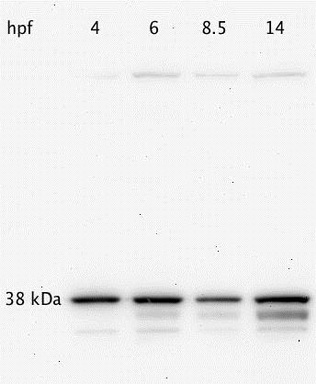GAPDH Mouse Monoclonal Antibody [Clone ID: 1D4]
Other products for "GAPDH"
Specifications
| Product Data | |
| Clone Name | 1D4 |
| Applications | IF, WB |
| Recommended Dilution | WB: 1:1000, IF: 1:100 |
| Reactivities | Bovine, Chicken, Hamster, Human, Mouse, Rat, Avian |
| Host | Mouse |
| Isotype | IgM, kappa |
| Clonality | Monoclonal |
| Immunogen | Purified porcine GAPDH [UniProt# P00355] |
| Formulation | Preservative: 0.1% Sodium Azide. Store at 4C short term. Aliquot and store at -20C long term. Avoid freeze-thaw cycles. |
| Concentration | lot specific |
| Purification | Tissue culture supernatant |
| Conjugation | Unconjugated |
| Storage | Store at -20°C as received. |
| Stability | Stable for 12 months from date of receipt. |
| Predicted Protein Size | 38 kDa |
| Gene Name | glyceraldehyde-3-phosphate dehydrogenase |
| Database Link | |
| Background | GAPDH, also known as Glyceraldehyde 3-Phosphate Dehydrogenase is a 146 kDa tetramer composed of four 30-40 kDa subunits. GAPDH is a metabolic enzyme responsible for catalyzing one step in the glycolytic pathway, the reversible oxidative phosphorylation of glyceraldehyde 3-phosphate. Levels of GAPDH mRNA are commonly used as standards in mRNA expression studies. GAPDH is highly expressed due to its role in many housekeeping functions. Increasingly, scientists are making use of specific antibodies to GAPDH as loading controls for western blotting experiments. Apart from a role in glycolysis, GAPDH may have other roles such as in the activation of transcription. GAPDH is reported to bind to a variety of other proteins, including the amyloid precursor protein. Associations with Actin and Tubulin have also been reported. The protein may also have a role in the regulation of apoptosis, and interestingly migrates from the cytoplasm into the nucleus when cells become apoptotic. |
| Synonyms | G3PD; GAPD; HEL-S-162eP |
| Note | This GAPDH Antibody (1D4) is useful for Western blot and Immunocytochemistry/Immunofluorescence. Immunohistochemistry was reported in scientific literature. In WB a prominent band can be seen at approximately 38 kDa. This antibody makes an excellent loading control for Western blot experiments. Use in immunprecipitation reported in scientific literature (PMID 24032460) |
| Reference Data | |
| Protein Families | ES Cell Differentiation/IPS |
| Protein Pathways | Alzheimer's disease, Glycolysis / Gluconeogenesis, Metabolic pathways |
Documents
| Product Manuals |
| FAQs |
{0} Product Review(s)
0 Product Review(s)
Submit review
Be the first one to submit a review
Product Citations
*Delivery time may vary from web posted schedule. Occasional delays may occur due to unforeseen
complexities in the preparation of your product. International customers may expect an additional 1-2 weeks
in shipping.






























































































































































































































































 Germany
Germany
 Japan
Japan
 United Kingdom
United Kingdom
 China
China






